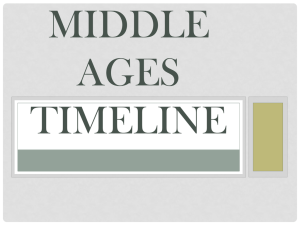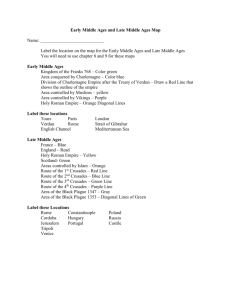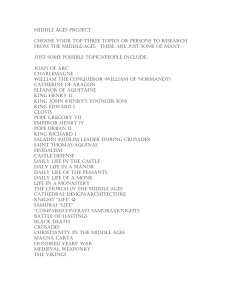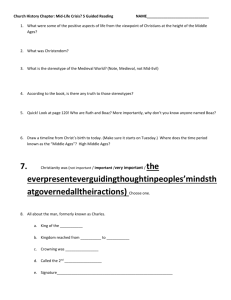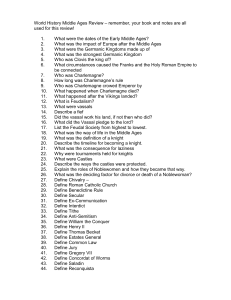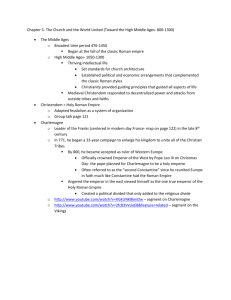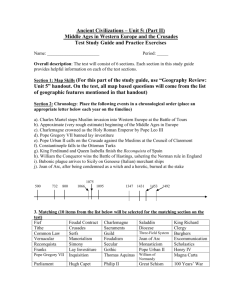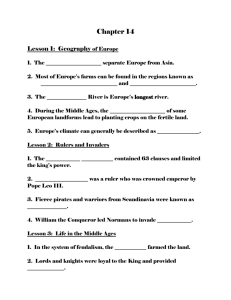grade 8 church history notes chapter 6
advertisement
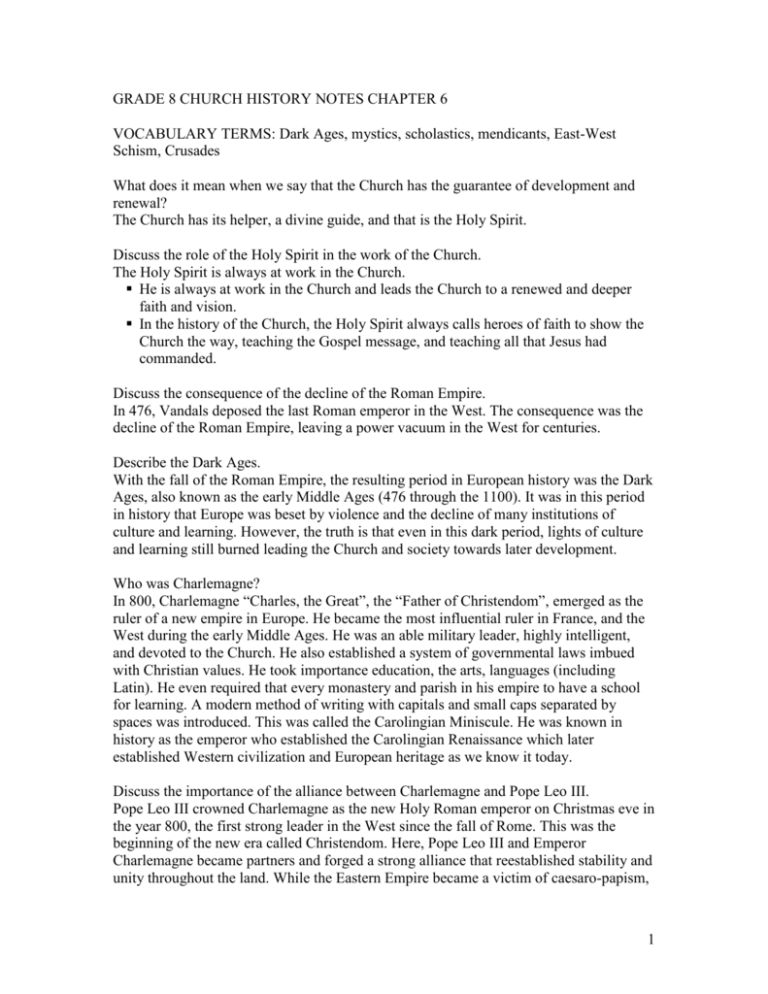
GRADE 8 CHURCH HISTORY NOTES CHAPTER 6 VOCABULARY TERMS: Dark Ages, mystics, scholastics, mendicants, East-West Schism, Crusades What does it mean when we say that the Church has the guarantee of development and renewal? The Church has its helper, a divine guide, and that is the Holy Spirit. Discuss the role of the Holy Spirit in the work of the Church. The Holy Spirit is always at work in the Church. He is always at work in the Church and leads the Church to a renewed and deeper faith and vision. In the history of the Church, the Holy Spirit always calls heroes of faith to show the Church the way, teaching the Gospel message, and teaching all that Jesus had commanded. Discuss the consequence of the decline of the Roman Empire. In 476, Vandals deposed the last Roman emperor in the West. The consequence was the decline of the Roman Empire, leaving a power vacuum in the West for centuries. Describe the Dark Ages. With the fall of the Roman Empire, the resulting period in European history was the Dark Ages, also known as the early Middle Ages (476 through the 1100). It was in this period in history that Europe was beset by violence and the decline of many institutions of culture and learning. However, the truth is that even in this dark period, lights of culture and learning still burned leading the Church and society towards later development. Who was Charlemagne? In 800, Charlemagne “Charles, the Great”, the “Father of Christendom”, emerged as the ruler of a new empire in Europe. He became the most influential ruler in France, and the West during the early Middle Ages. He was an able military leader, highly intelligent, and devoted to the Church. He also established a system of governmental laws imbued with Christian values. He took importance education, the arts, languages (including Latin). He even required that every monastery and parish in his empire to have a school for learning. A modern method of writing with capitals and small caps separated by spaces was introduced. This was called the Carolingian Miniscule. He was known in history as the emperor who established the Carolingian Renaissance which later established Western civilization and European heritage as we know it today. Discuss the importance of the alliance between Charlemagne and Pope Leo III. Pope Leo III crowned Charlemagne as the new Holy Roman emperor on Christmas eve in the year 800, the first strong leader in the West since the fall of Rome. This was the beginning of the new era called Christendom. Here, Pope Leo III and Emperor Charlemagne became partners and forged a strong alliance that reestablished stability and unity throughout the land. While the Eastern Empire became a victim of caesaro-papism, 1 the Western empire had political authority with the sanction of the Church. The Church also had the backing and protection of the earthly kingdom of Charlemagne. This alliance was the cooperation between the Church and a temporal king. What is the East-West Schism? What was the cause of this division? What kept the lamp of learning aglow during the Dark Ages? The development and renewal of monasticism kept the lamp of learning aglow in the West during this period of European history, in part thanks to the system that was put in place by Charlemagne and his Carolingian Renaissance. What were the contributions of St. Columba? St. Columba (521-597), the patron saint of Scotland, spent 15 years in and around Ireland preaching about Christ and established monasteries. Saint Columba and his monks created a haven of culture and learning at the time of ‘darkness’ in Scotland. He established the island of Iona, Scotland as a center of missionary activity in Ireland, Scotland, and northern England. Who was St. Hildegard and what was her contribution to the Church during the early Middle Ages? St. Hildegard (1098-1174) lived her life according to the Rule of St. Benedict. She was a mystic and was gifted with remarkable intelligence. She was also a poet, physician, and composer. Define “mystic?” A mystic is defined as a person who receives the gift of an intense experience of union and communication with God. Define “mendicant.” The word ‘mendicant’ comes from a Latin word which means ‘to beg.’ Mendicants dedicate themselves to living the Gospel ideal of poverty and belong to a way of living and preaching the Gospel approved by the Church, which includes begging for food and whatever else is needed to support their work. What are two mendicant orders? Two mendicant orders are the Dominicans (Order of Preachers, or O.P.) and the Franciscans (Order of Friars Minor or O.F.M). St. Francis and St. Dominic begged for food and lodging as they traveled about preaching the Gospel. Describe briefly the life of St. Francis of Assisi. St. Francis of Assisi was the son of a wealthy cloth merchant. Living a cavalier life and wanton desire, he made a turnaround in his life. While in prayer at church, he received the call to rebuild God’s Church. Resolving to serve Christ, he traveled to Rome and obtained permission to establish the ‘brotherhood.’ The word ‘friar’ means ‘brother’ The word ‘minor’ is a distinction of a minor class of merchants.(Majores would be a class 2 distinction for nobles) According to St. Francis, the true minors were not merchants but social outcasts. Describe briefly the life of St. Dominic of Guzman. While visiting Rome with his bishop (c1203), Dominic of Guzman was inspired to become a mendicant preacher. He then founded the Order of Preachers (better known as the Dominicans) in the year 1216. The mission of the Dominicans is to preach the Gospel and teach the Catholic faith. Like the Franciscans, the Dominicans are a mendicant order. Define “Scholastics.” Scholastics are 12th and 13th century theologians who used the study of philosophy to create a system of Christian teaching. The term ‘Scholastics’ means ‘schoolmen’ and used human reasoning to explain the teachings of the Church. What events in history brought about scholasticism? While Europe was in the Dark Ages, eventually social stability was returning in the 12th and 13th centuries. Business and commerce began to thrive and urban cities were becoming more stable. At the same time, education and learning became possible outside of the monastery schools. From here colleges and universities began to be established. Who were the saints that were famous for bringing about scholasticism? Notable scholastics include St. Thomas Aquinas, OP, and St. Bonaventure, OFM. Briefly discuss the life of St. Thomas Aquinas. Educated in a Benedictine monastery, Thomas Aquinas studied the Greek philosophy of Plato and Aristotle. In 1244, he joined the Order of Preachers, studied in Paris and Cologne. Later as a priest, he became a master teacher of theology. He commented on Sacred Scripture, answered questions about the faith, and preached. He wrote the ‘Summa Theologica’ which is a summary of theology. Briefly discuss the life of St. Bonaventure. Saint Bonaventure was a biographer of St. Francis of Assisi. As a priest, he also taught theology and later became the superior general of the Franciscans. He wrote books on spirituality in the mendicant way of life. He wrote Journal of the Soul into God. Briefly describe the life of Pope Innocent III and his role in the Church and the world. As Europe emerged from the Middle Ages, the papacy still continued to play a key role in society. Such was the case of Pope Innocent III who was intensely involved in the reform of the Church as well as the affairs in the world. He was pope from 1198 to 1216. In 1215, he presided over the Fourth Lateran Council. He was also involved in the Fifth Crusade. As the pope, Innocent III claimed the right to intervene in affairs of secular rulers. His office marks the climax of the temporal power of the Pope during the Medieval Period. 3 Briefly describe the Crusades and the purpose of the Crusades. The First Crusade began in the year 1096 and the last of the Crusades ended in 1291. The First Crusade began under the pontificate of Pope Urban II with the aim of bringing Jerusalem and the Holy Land from Muslim control and under Christian control and open to Christian pilgrims. Most of the Crusades ended in failure. Describe how media might work with God and the Church’s mission of spreading the Good News. Since the beginning, the Church has fulfilled its mission of preaching the Gospel, inviting all to become followers of Jesus. Today, because of the use of communications media, it is somewhat easier to fulfill this mission. With the click of a button, communication is almost instantly transmitted worldwide the message of Jesus Christ through radio, television, and the web. The question is how media can work with God and for God in dissipating information and to attract those who are searching for God in their lives. How can the use modern technology be used as an instrument to learn about and share in the faith of the Church? 1. Mass is heard everyday through radio and television broadcast with such networks as EWTN. Such programs are designed for people who are unable to participate in celebrating Mass in their home parish. 2. The web is filled with messages and information about Jesus and also the Church. One only has to log in to the internet and learn about the saints, the Church, and Jesus. Most if not all parishes have their on web pages that offer the different ministries that are present to serve its members. 3. The U.S. Conference of Catholic Bishops and the Vatican have their own websites that has many sources and information about the Catholic Church What does it mean to be a herald and servant of the Gospel? A Christian herald proclaims and invites others to accept the good news of God’s love revealed through Jesus Christ. A Christian servant serves and helps others as Christ Himself did. In what ways can you fulfill your responsibility to be a herald of the Gospel? p 66 In what ways can you fulfill your baptismal call to serve the Church and others? p. 67 4
